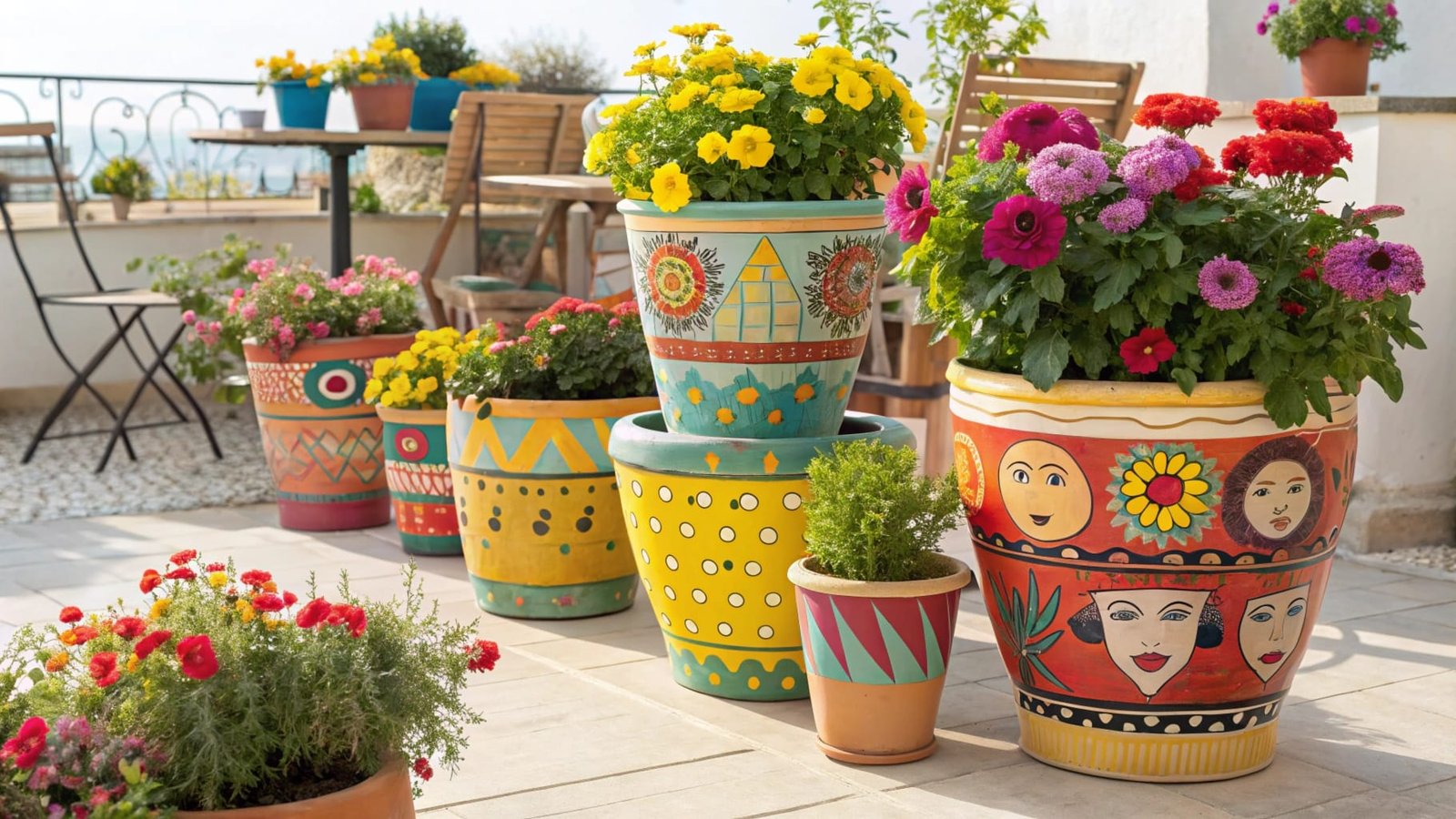
Transforming your patio with plants is a rewarding experience. Whether you're a seasoned gardener or a beginner, creating vibrant and stylish pot projects is easier than you think. With just a few simple steps, you can bring color, texture, and life to your outdoor space. From colorful flower gardens to creative succulent arrangements, patio pots provide endless opportunities to express your personal style. The beauty of these projects is that they can be tailored to any level of gardening expertise and can be adjusted to suit any climate or aesthetic preference.
Creative patio pot projects, from colorful flower gardens to easy succulent arrangements, can instantly elevate your outdoor space.
Transform your patio by incorporating plants into easy and fun pot projects. Let’s dive into how you can achieve stunning designs with simple materials and techniques. Whether you have a small apartment balcony or a spacious backyard patio, these ideas will help you create a beautiful garden that suits your needs.
How can I create a colorful flower garden in patio pots?
Creating a colorful flower garden in patio pots is a fantastic way to brighten up your outdoor space. A mix of blooming flowers can bring vibrant hues and delightful scents to your patio. But how do you ensure that your plants look cohesive and visually appealing? Let’s explore how to achieve a gorgeous display.
A mix of colorful flowers in patio pots adds vibrancy. Consider plant combinations based on color, size, and texture for the best visual impact.
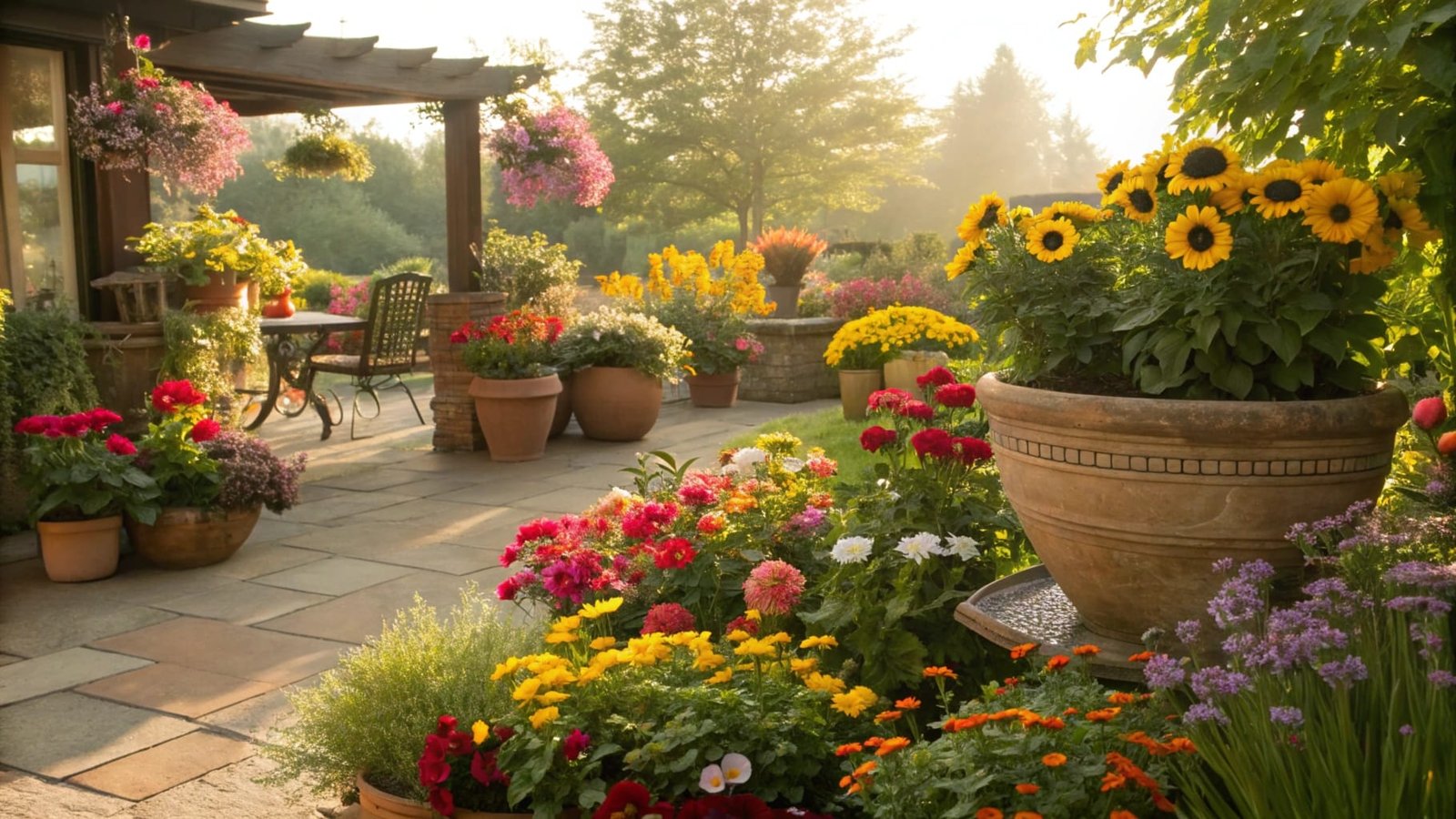
Start with the Right Plants
The first step in creating a colorful flower garden is to choose the right plants. Not all flowers are suitable for patio pots, so it’s important to select species that thrive in containers and your climate. Depending on your location, you might want to go for annuals, perennials, or a combination of both. Annuals, such as petunias and geraniums, offer vibrant, non-stop blooms throughout the season, making them ideal for adding color to your patio. Perennials, on the other hand, like coneflowers, lavender, or daylilies, offer seasonal beauty and will return year after year, providing long-term satisfaction.
- Annuals like petunias, marigolds, and geraniums bloom all season long and come in a variety of colors.
- Perennials, such as coneflowers, lavender, or daylilies, offer seasonal beauty and will return year after year.
Choosing Colors and Textures
When designing your patio flower garden, think about the color palette and how different flowers interact with each other. A few tips for a well-balanced garden:
- Monochromatic: Choose flowers in one color range, like shades of purple or red. This creates a calm, harmonious effect that is visually pleasing.
- Contrasting colors: Complementary colors (such as yellow and purple or orange and blue) can create a striking contrast, adding drama to your garden.
- Textural variety: Combine flowers with different textures—smooth, spiky, or soft foliage can make your garden visually interesting. Think about mixing tall, spiky flowers like foxgloves with soft, rounded plants like daisies.
Container Arrangement
When selecting containers, consider their size and shape. Large, deep containers provide more space for root systems, allowing plants to grow better, while shallow pots are perfect for compact flowers. A few design principles to keep in mind:
- Thrillers, fillers, and spillers: A common design rule is to have a "thriller" (a tall, dramatic plant), a "filler" (a medium-sized plant to fill the space), and a "spiller" (a plant that drapes over the edge). For example, you might plant a tall sunflower (thriller) in the center, surround it with petunias (fillers), and add trailing ivy (spiller) around the edges.
- Layering: Put taller plants in the center or back of the pot, medium ones in the middle, and trailing plants near the edges. This creates depth and visual interest.
Tips for Success
- Use a good-quality potting mix with plenty of drainage to avoid root rot. Make sure your pots have drainage holes to allow excess water to escape.
- Water regularly but ensure your pots don’t sit in water to prevent root damage. If you have multiple pots, consider using a drip irrigation system for convenience.
- Add slow-release fertilizer to help your flowers thrive throughout the season. This will ensure they get the nutrients they need without the hassle of frequent fertilizing.
What are some easy succulent arrangements for patio containers?
Succulents are perfect for patio pots. They’re low-maintenance, come in various shapes, and are available in different colors and textures. Here are some ideas for easy succulent arrangements you can make for your patio.
Succulent arrangements are easy to maintain and offer a variety of shapes and colors. Pair different textures to create a unique display.
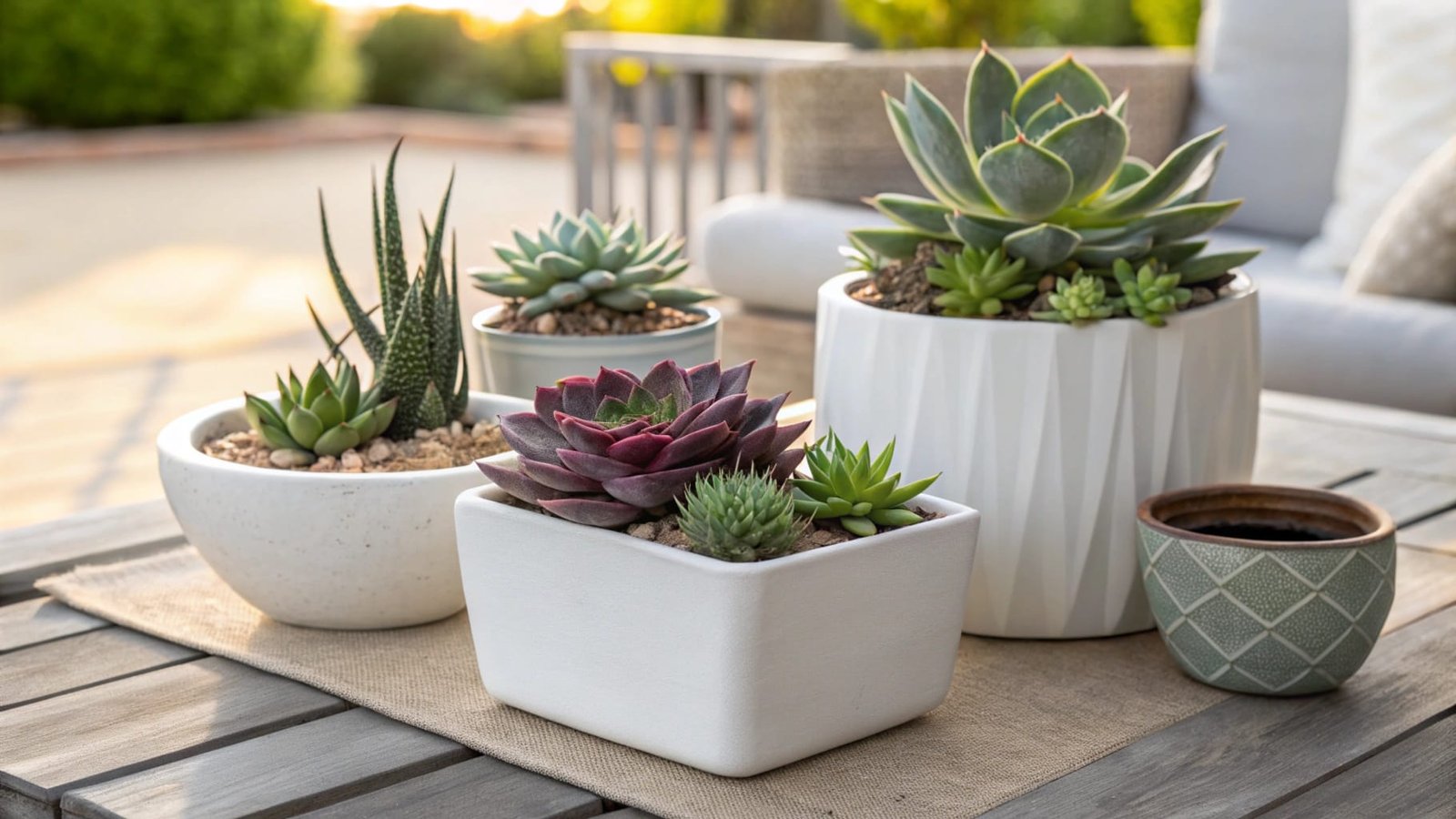
Selecting the Right Succulents
The beauty of succulents lies in their versatility. These hardy plants are perfect for creating vibrant arrangements in small pots or larger containers. Choose a mix of different types for variety:
- Echeveria: These rosette-shaped succulents come in soft pastel hues, like pinks, purples, and blues, making them an excellent choice for a calm, muted aesthetic.
- Sedum: Known for their trailing qualities, sedums like "Dragon’s Blood" are perfect for spilling over the edge of containers and creating a cascading effect.
- Aloe Vera: Not just for the garden, Aloe Vera can add a bit of height and drama to your pot, with its bold, spiky form.
- Cacti: These spiky plants add an interesting texture and contrast to other succulents. Choose varieties that suit your climate, as some cacti are better suited to cooler environments than others.
Designing the Arrangement
When it comes to designing succulent pots, here are a few ways to create an eye-catching display:
- Mixed textures: Combine smooth-leaved succulents like Echeveria with spiky ones like Aloe Vera for a textural contrast. The variety in leaf shape and size creates a more dynamic and engaging design.
- Symmetrical designs: Arrange succulents in a pattern for a neat, balanced look. A symmetrical arrangement can give your patio an orderly, formal aesthetic, perfect for modern and minimalist spaces.
- Zen garden: For a peaceful, serene design, use large succulents with stones or gravel as the base. This will create a calming effect on your patio, ideal for creating a tranquil escape.
Caring for Succulents
Succulents are known for being low-maintenance, but a few tips will help them thrive:
- Water sparingly: Succulents don’t need much water. Water when the soil is dry to the touch, and avoid letting them sit in water. A general rule is to water thoroughly but infrequently.
- Ensure proper sunlight: Succulents thrive in bright, indirect sunlight. Make sure your patio gets enough light for them to flourish. Too much direct sunlight can burn their leaves, while too little can cause them to stretch and become leggy.
- Well-drained soil: Make sure your pots have drainage holes and use a mix designed specifically for succulents, which is usually gritty and fast-draining.
How do I design a low-maintenance herb garden for my patio pots?
Herb gardens are a great addition to any patio, offering both beauty and practicality. A well-planned herb garden in pots can be low-maintenance and provide fresh herbs all season long. Here’s how to create one for your outdoor space.
A low-maintenance herb garden in patio pots can offer fresh herbs year-round. Choose hardy herbs and proper containers for the best results.
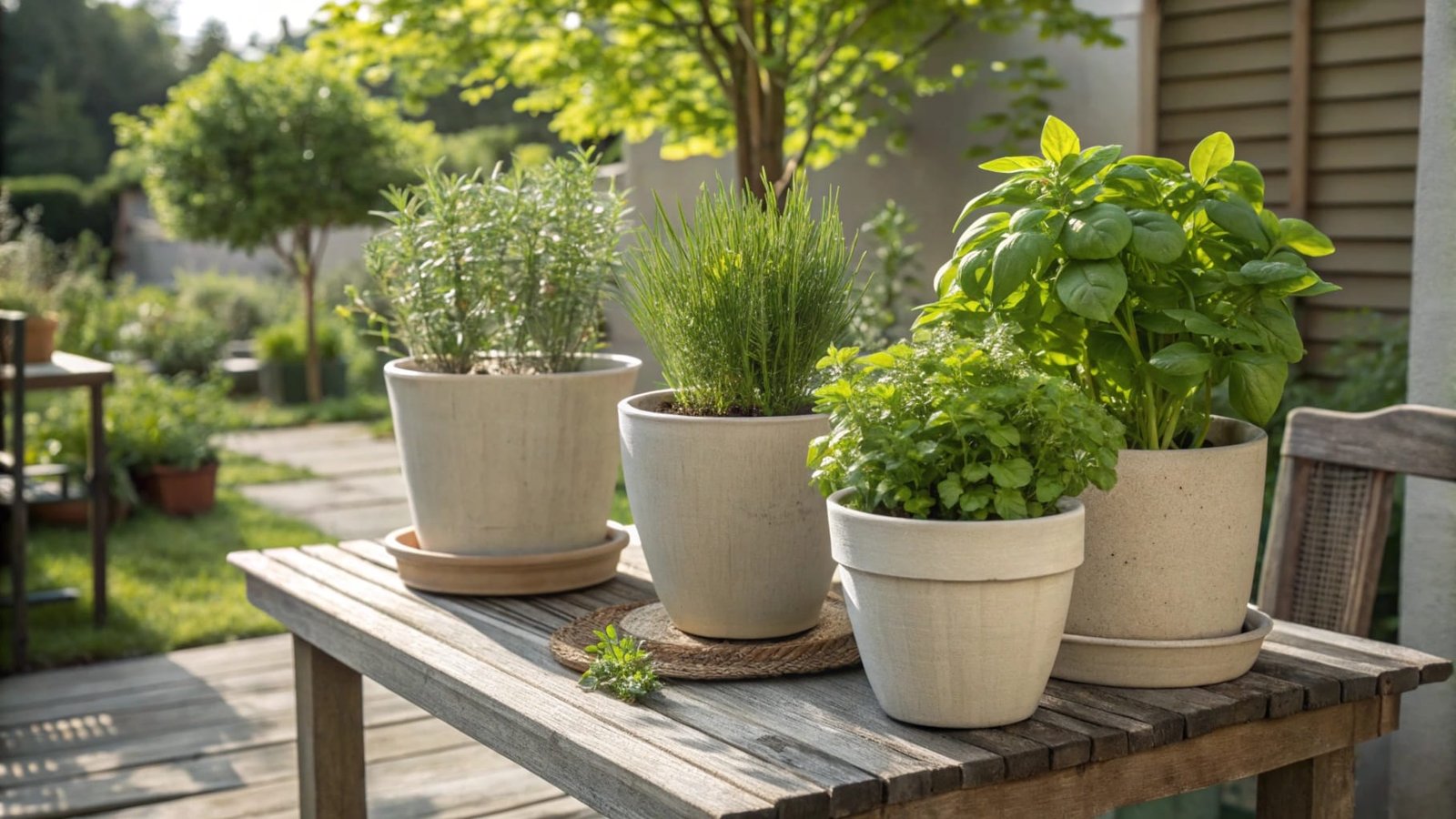
Choosing the Right Herbs
Herbs are naturally suited to containers, and many are hardy and easy to grow. Consider these popular low-maintenance options for your patio:
- Basil: A must-have for any herb garden, basil thrives in full sun and can be harvested regularly.
- Mint: Grows quickly and can tolerate some shade, but be sure to plant it in a separate pot, as it spreads aggressively and may overtake other plants.
- Thyme: A hardy herb that requires minimal care and can handle heat. It’s perfect for growing in a sunny corner of your patio.
- Rosemary: Prefers dry soil and full sun, making it a great choice for low-maintenance gardens. It also adds a lovely fragrance to your patio.
Pot Selection and Placement
Choosing the right pot is crucial for the health of your herb garden. Make sure to select containers with good drainage to prevent waterlogging. A few tips:
- Self-watering pots: These are a great option for keeping herbs hydrated without over-watering them. Look for self-watering containers that can provide consistent moisture without the risk of waterlogging.
- Larger containers: Some herbs, like rosemary and sage, need more space to spread their roots. Large pots will give them the room they need to grow vigorously.
Easy Care Tips
Low-maintenance herbs still require some care, but here are simple ways to ensure your garden thrives:
- Water consistently but avoid overwatering: Most herbs like to dry out between waterings. Check the soil to see if it’s dry before watering, as too much water can cause root rot.
- Prune regularly: Pinch back growth to promote a bushier plant and prevent them from becoming leggy. Removing flowers that appear will help the plant focus on growing more leaves.
- Harvest frequently: Regular harvesting not only provides fresh herbs but also encourages new growth, ensuring that your garden will continue to provide fresh ingredients for cooking.
What creative ways can I use hanging or tiered pots for patio plants?
Hanging and tiered pots are excellent ways to save space while adding vertical beauty to your patio. These creative designs let you experiment with different plants and arrangements. Here are some tips for using hanging or tiered pots on your patio.
Hanging and tiered pots save space and add vertical beauty to your patio. Consider plants that can cascade down or create layers of interest.

Choosing the Right Hanging Plants
Hanging pots are perfect for plants that cascade or trail down. Consider these types of plants for hanging containers:
- Petunias: Their trailing flowers make them an excellent choice for hanging baskets, providing a burst of color that flows down.
- Ferns: Soft, green fronds create a lush, cascading effect that looks perfect in hanging baskets or containers.
- Trailing begonias: Known for their vibrant blooms and cascading nature, begonias thrive in hanging baskets, adding both color and movement to your space.
Using Tiered Pots for Layered Design
Tiered pots allow you to create a multi-level garden that’s visually striking. Here’s how you can make the most of tiered containers:
- Compact plants at the top: Start with smaller plants or trailing vines like ivy at the top tier. These will provide a nice contrast to larger plants below.
- Medium-sized plants in the middle: Use medium-height flowers or herbs, such as marigolds or basil, in the middle tiers. These plants will fill out the design without overwhelming it.
- Full-sized plants at the bottom: Finish off with larger plants, like geraniums or petunias, that can fill out the base. Their blooms will help anchor the design and add depth.
Creative Plant Combinations
Mixing different types of plants in hanging or tiered pots can create dynamic displays. Some combinations to consider:
- Herb and flower combo: Grow a mix of herbs like basil and thyme along with colorful flowers like pansies or marigolds. This combination provides both visual appeal and functionality.
- Succulent tiers: Combine small, colorful succulents in each tier for a striking effect. Their compact size and variety of colors make them ideal for layered designs.
Maintenance Tips
- Regular watering: Hanging and tiered pots tend to dry out faster, so ensure you water them frequently, especially in hot weather.
- Pruning: Regularly prune cascading plants to keep them from getting too unruly.
How can I incorporate unique or unusual plants into my patio pot collection?
If you want your patio garden to stand out, why not incorporate some unique or unusual plants into your pots? These plants will add a distinctive touch and become conversation starters. Let’s explore some options.
Unusual plants can give your patio pot collection a unique and memorable look. Look for rare textures, colors, or forms to stand out.
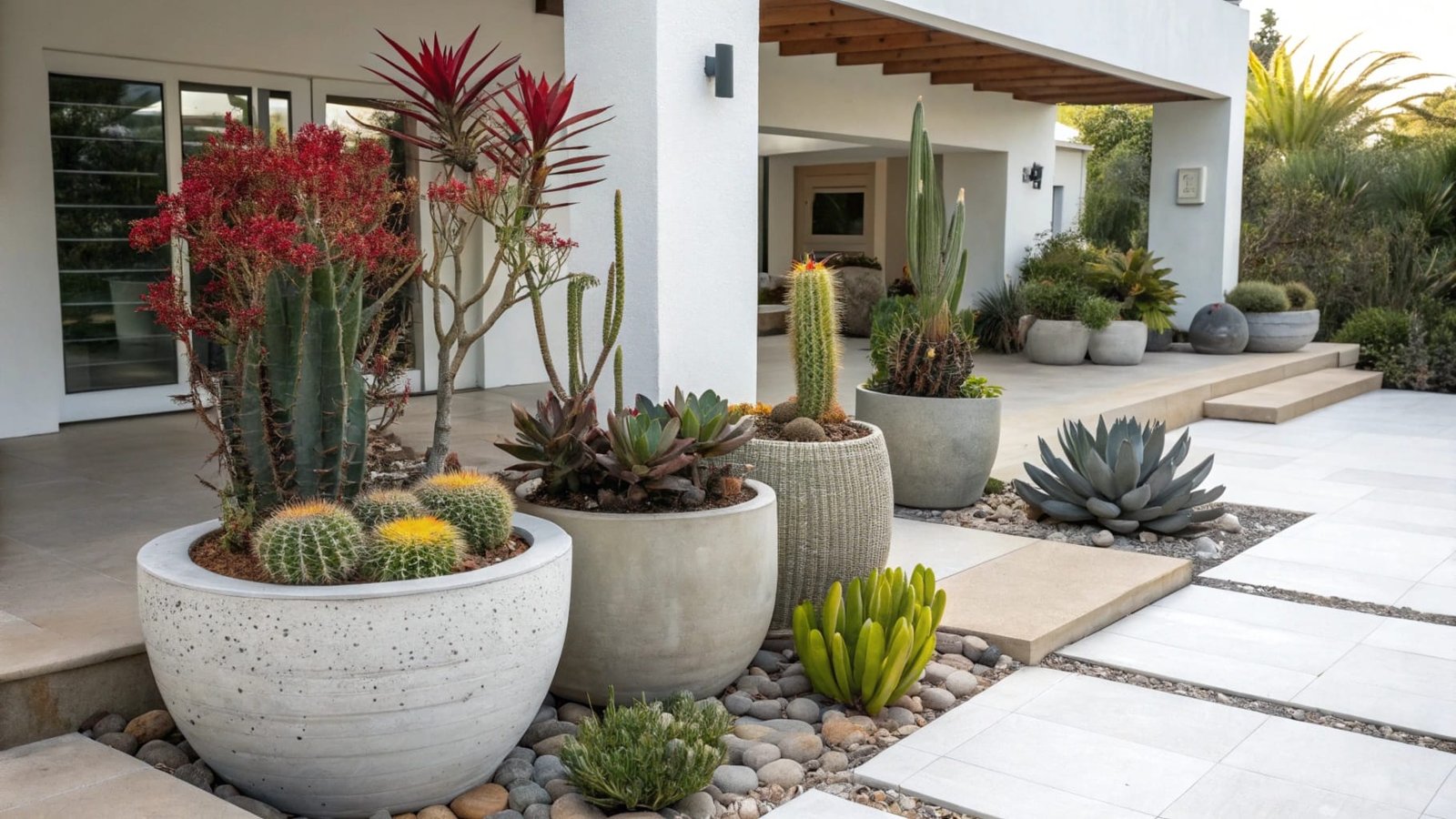
Uncommon Plant Options
Here are some unique plants that can make your patio pot collection truly special:
- Elephant Ear1: With large, dramatic leaves, Elephant Ear can create a tropical vibe on your patio. Its bold size and shape make it an eye-catching centerpiece.
- Creeping Jenny2: Known for its vibrant yellow-green leaves, this plant adds both texture and color to your containers. It’s great for trailing down the sides of pots.
- Black Mondo Grass3: This plant has striking dark foliage and adds a touch of mystery to your garden. It’s perfect for a modern, minimalist aesthetic.
- Coral Bells4: With their colorful foliage, Coral Bells are a great addition to any unusual garden display. Their colors range from deep red to purple and orange.
How to Use Unusual Plants Creatively
To make the most of unique plants, it’s important to pair them with complementary plants and use them in the right context:
- Contrasting textures5: Pair smooth-leaved plants with spiky or textured plants for visual interest and diversity.
- Bold color choices6: Choose unique plants with bright or unusual colors to make a bold statement. For example, a plant with silver or burgundy leaves can really pop against green plants.
Mixing with Familiar Plants
While unusual plants are eye-catching, mixing them with more traditional varieties can help balance out the design. A few tips for combining the two:
- Focal points: Use unique plants as focal points in your design and surround them with more common plants for a balanced arrangement.
- Balance: If using bold-colored plants, balance them with neutral greens or whites to avoid overwhelming the space.
Conclusion
With a little creativity, you can transform your patio into a stunning garden with colorful flowers, easy succulents, low-maintenance herbs, and unique plants. Try these fun projects to create your own outdoor oasis!
A comprehensive guide to caring for Elephant Ear plants, including soil, light, and watering tips. ↩
This resource explains how to care for Creeping Jenny, a vibrant plant ideal for hanging or trailing in containers. ↩
Learn how to incorporate Black Mondo Grass into your garden design, adding a modern touch with its unique dark foliage. ↩
A guide to growing and caring for Coral Bells, focusing on their colorful foliage and versatility in various garden styles. ↩
Explore ideas for combining unusual plants with traditional varieties in your containers to create a balanced, dynamic display. ↩
Learn how to pair plants with contrasting textures and colors to create visually appealing container arrangements. ↩


